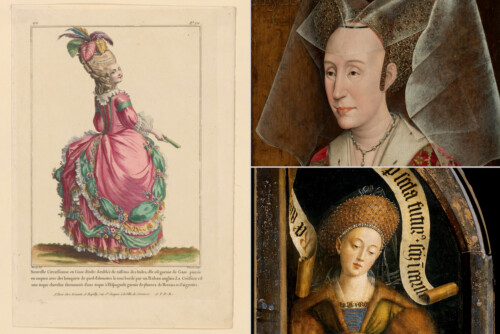Playing with Fire?
Maintenon was versatile in her manner of playing with illusion. Her “Conversation sur les Agrémens” (Conversation on enchantments) proceeds as if no spectators were present – that is, as if the conversation were private and not a performance.1 Indeed, in the presence of visitors, the words exchanged were intended as much for their ears as for those of the participants. This was true even when the visitor was the king: “Le Roy Louis XIV les agréait fort, et y trouvait une agréable solidité qui lui faisait prendre plaisir à les entendre.” (King Louis XIV highly approved of them and found in them a pleasing soundness that he took pleasure in watching.)2 Near the beginning of the “Conversation sur les Agrémens,” a speaker defines “les agrémens” as “faire toutes nos actions comme si nous avions pour témoins les personnes du monde auxquelles nous aurions le plus d’envie de plaire” (acting as if we had as witnesses the members of the elite whom we would want to please the most).3 When another speaker responds, “Quoi!” (What?), echoing the beginning of Molière’s 1662 Les Femmes savants (The know-it-all ladies), the interjection attracts attention and signals the importance of her following words: “Je serois toûjours comme si j’étois devant le Roi & je ne serois jamais en liberté!” (I would always act as if I were in front of the King and I would never feel free!)4 This conversation was likely performed before Louis XIV; Maintenon had her students pretend to speak naturally in his absence and with inhibition in his presence. Another speaker adds: “On voit si peu le Roi, qu’il ne faut devant lui qu’un air respectueux & attentif, mais si on avoit l’honneur d’être dans sa familiarité, il faudroit rire de bonne grace devant lui, manger aussi de même en sa presence; en un mot, trouver sa liberté en faisant toûjours bien ce qu’on fait.” (Since we see the king so rarely, we should only appear respectful and attentive before him, but if we had the honor of being on more familiar terms with him, we would want to laugh gracefully in front him and even eat in his presence. In a word, we would have to find a way to feel free while always acting impeccably.)5 As protégées of Maintenon and Louis XIV, the students of Saint-Cyr enjoyed familiarity with the royal couple. What better way to enter into complicity with the king than to pretend to ignore him?
Maintenon’s playfulness in the Conversations went so far as to ironize her institutional policies and practices. The speakers enjoy more liberties than the real students ever did. For instance, several exchanges begin with a speaker recounting her experience in a salon at some fine residence, as in the “Conversation sur l’indiscrétion” (Conversation on indiscretion): “Je sors d’un lieu où j’ai bien souffert; il y avoit un très-honnête homme qui étoit bossu; une jeune Dame a parlé longtemps devant lui des avantages d’une belle taille.” (I have just left a place that I could not stand: there was a nice gentleman with a humped back, and a young lady was speaking endlessly in his presence about the advantages of cutting a handsome figure.)6 In the “Conversation sur la Douceur” (Conversation on gentleness), the speaker discusses a debate she attended: “Je sors d’un lieu où l’on a bien disputé; les unes soûtenoient que Madame de … étoit douce & les autres prétendoient qu’elle ne l’étoit point du tout.” (I have just left a fine debate; some people were arguing that Madame de … is gentle, and others were insisting that she is not at all.)7 In the “Conversation Sur le Danger des mauvaises companies” (Conversation on the dangers of bad company), the speaker reports partaking in a salon in the company of men: “Il est vrai qu’il y avoit beaucoup d’hommes. Je ne sais si les femmes étoient coquettes, mais je sais bien que la conversation fut vive, gaie et spirituelle, et que je ne me suis jamais mieux divertie.” (It is true that there were many men present. I do not know if the women were too coquettish, but I know that our conversation was energetic, joyful, and witty, and that I have never had such a good time.)8 In practice, unlike the speakers they pretended to be, the students were only allowed to visit Maintenon and the king at Versailles, accompanied by their teachers and guarded from courtiers’ gaze. Visitors knew that the social outings that the students described were fictional. Maintenon may have intended to indulge the students’ dreams of entering salon society instead of practicing controlled simulations. Thus emerges a dizzying juxtaposition of freedoms, real and simulated: the students pretended to speak freely and spontaneously while reciting imposed texts in a concerted performance.
When Maintenon portrayed polite society to her students, the image of diverse pleasures never totally eclipsed that of hypocrisy, treachery, and pain. These famous lines reveal her ambivalence toward salon culture:
Ô mes chères filles, que vous êtes heureuses d’avoir quitté le monde! il promet joie et n’en donne point. Le roi d’Angleterre jouoit hier dans ma chambre avec Mme la duchesse de Bourgogne et ses dames à toutes sortes de jeux; notre Roi et la reine d’Angleterre les regardoient; ce n’était que danses, ris et emportements de plaisirs et presque tous se contraignoient et avoient le poignard dans le cœur. Le monde est certainement un trompeur; vous ne pouvez avoir trop de reconnoissance pour Dieu de vous en avoir tirées.
(Oh, my dear girls, how lucky you are to have left the world outside! It promises joy and gives none. Yesterday in my chambers, the King of England was playing all sorts of society games with Madam the Duchess of Burgundy and her ladies. Our King and the Queen of England were watching them: there was nothing but dancing, laughter, and effusions of pleasure, and almost everyone was forcing a smile with a knife in their heart. Society is certainly a fraud; you can only be too grateful that God has drawn you away from it.)9
Maintenon spared no detail: she must have realized how tantalizing the dancing, laughter, and effusions of pleasure were for her young protégées. Her Conversations ironize Saint-Cyr’s policy of seclusion, which was nonetheless scrupulously upheld. By having them recount fictitious forbidden social outings, Maintenon demonstrated empathy toward her students: she knew her policy could be frustrating for them and she offered a sympathetic ear, if nothing else, to their longings for a more mondaine existence.
Student frustration, seen obliquely through these fantasy outings, appears intensely and directly in the “Conversation sur l’Éducation à Saint-Cyr.”10 Unsurprisingly, most of the speakers here sing the praises of Saint-Cyr and especially of the Conversations. They describe this practice as a pleasure that has been offered to them: “Je suis charmée, Mesdemoiselles, des conversations qu’on nous a données pour nous diverter.” (I am enchanted, mesdemoiselles, with the conversations that have been given to us for our amusement.) They also see it as more meaningful and enjoyable than other recreational activities: “Il est vrai, Mademoiselle, que tous les jeux qu’on pourroit nous permettre nous donneroient moins de plaisir.” (It is true, Miss, that all the games we are allowed to play would give us less pleasure.) Moreover, they admire the manner in which these scripts reconcile pleasure and instruction: “Jamais on ne pouvoit trouver une invention plus agréable & plus utile en même tems.” (Never could one invent a practice at the same time more pleasurable and more useful.)11 Maintenon makes no effort to disguise the institutional discourse: “Elle [Maintenon] fit plusieurs petits entretiens sur differents sujets qui en divertissant par leur agrément donoient de solides instructions.” (She created several small dialogues on different topics, each offering solid instruction with entertaining elegance.)2 However, she does not simply propagandize; one speaker complains about the school and its practices. Mlle 3 is weary of conversing about abstract qualities and exemplary behaviors, and does not mince her words: “Je suis blessée du désir continuel de s’instruire qui regne ici.” (I cannot stand the continuous desire for instruction that reigns here.)12 She wishes that the students were allowed to have fun during recess, without the intrusion of authority: playing, dancing, and jumping are more “natural” to young people than pretending to be precocious salonnières.
Through Mlle 3’s persistent complaints, Maintenon provides ample opportunity for other speakers to enthusiastically defend Saint-Cyr. Mlle 6 retorts: “Pour moi, je ne croirai jamais qu’en nous instruisant de notre Religion, & en nous donnant de la raison, on nous rende malheureuses.” (As for me, I will never believe that by instructing us about our religion and teaching us how to have sound judgment, they are making us unhappy.)13 As the editor Venesoen notes, the voice of reason needs a voice of dissent to vanquish: “Afin de mettre en valeur la dialectique inattaquable de Madame de Maintenon, il fallait quelques voix de dissension, des objections ça et là; il fallait des frondeuses qu’il s’agissait de convaincre et de gagner à la cause de la raison et de la sagesse!” (In order to bring out her excellent dialectic skills, Madame de Maintenon had to include a few voices of dissension, some objections here and there; she needed rebellious characters to convince and to win over to the path of reason and wisdom!)14 Mlle 3 refuses to recognize the school’s merits. By creating such an obstinate character to represent serious frustrations and dissent, is Maintenon not playing with fire?
The “Conversation sur l’Éducation à Saint-Cyr” seems to expose the underside of Maintenon’s pristine institution extolled by Scudéry, Racine, and other visitors. Mlle 3 is a bad seed whose protests could wreak havoc should they fall on vulnerable ears. Venesoen, intrigued by the disgruntled speakers in several conversations, wonders if they express Maintenon’s private doubts and fears about her institution, “mais qu’elle les pourfendait à coups de sentences hautement moralisatrices” (which she stabbed repeatedly with highly moralizing maxims).15 Was there a prototype for Mlle 3 at Saint-Cyr? Was she Maintenon’s invention, the opposite of her “dear girls,” whose bad example comforted them in their good behavior? Or did Mlle 3 represent what Maintenon sensed that her students secretly felt?
If surviving textual evidence does not provide a definitive answer, it is evident that Maintenon considered “murmuring,” understood as covert grumbling, to be problematic at Saint-Cyr. Maintenon warned headmistress du Pérou in a letter: “Les filles en murmurent dans leur cœur d’autant plus amèrement qu’elles n’osent presque en parler.” (The girls murmur in their hearts even more bitterly than when they dare to speak up.)16 In 1702, she told her teachers: “Quel avantage de contenir de jeunes personnes qu’il est si dangereux d’abandonner à elles-mêmes dans ces temps de récréation, où les conversations entre elles sont si pernicieuses!” (How important it is to control young people during those dangerous moments of recess. They cannot be left to themselves, for their own conversations are so pernicious!)17 The “Conversation sur l’Éducation à Saint-Cyr” suggests that Maintenon sought to bring this murmuring to light in order to eradicate it. Mlle 3’s discourse may have served this end.
Maintenon could have represented this dialectic between only two speakers; instead, she chose a salon, which here represents the Communauté de Saint-Louis. Throughout her Conversations, the community is able to discern and defend reason through open communication. The students’ collective reasoning both manifests and dissimulates Maintenon’s authority. By containing the voices of dissent within in ludio (a game), the Communauté de Saint-Louis could make light of them and reduce any threat they may have posed.
In this context, student insolence was handled in the spirit of Salesian eutrapelia. Maintenon knew that sermonizing, harsh discipline, or even exclusion would not eliminate murmuring. Raillery was more effective in correcting undesirable behaviour – but should not degenerate into malicious mockery, which would lead to unhappiness, resentment, and more defiance. Eutrapelia, or lightly poking fun at “les occasions frivoles que les imperfections humaines fournissent” (the trivialities that human imperfection offers), was the essence of good conversation and good judgment, according to Saint François de Sales, whose Introduction à la vie devote (Introduction to a life of piety) was another required reading at Saint-Cyr.18 De Méré, Maintenon’s former mentor, called this playful teasing il condimento (spicing up conversation). He used it, in a less Christian spirit, to play with certain interlocutors: “Il y a des gens qui ne plaisent que lors qu’on les pique, et qu’on les met en jeu … Quand on ménage ces sortes de gens par quelque loüange douteuse & suspecte, qui les tienne en suspens, leur mine, leurs façons les rendent de bonne compagnie.” (There are people who are only fun to be with when you tease and play them … You can manipulate these sorts of people by dropping a doubtful compliment that leaves them hanging: their facial expressions and way of acting will make them amusing company.)19 In one of her Lettres sur l’éducation des filles, Maintenon claimed to have given her students “ce tour d’esprit railleur” (this knack for teasing).20 The “Conversation sur l’Éducation à Saint-Cyr” enabled students to practice raillery the right way.
Given that all eighteenth- and nineteenth-century editions of Maintenon’s Conversations name the speakers, Venesoen is surprised that the original manuscripts only number them.21 Keep in mind that these dialogues were performed by students speaking as student characters before other students; it is understandable that Maintenon wanted to maintain a distance between reality and representation. If Mlle 3 in the “Conversation sur l’Éducation à Saint-Cyr” was based on a real student, eutrapelia would have given way to disparagement had she been named. Assigning numbers allowed for vague identification. What better example of il condimento? Maintenon’s numbered characters could keep her real students wondering who among them was being exposed.
Frustrated and insolent, Mlle 3 repeatedly points to problems at Saint-Cyr. The other speakers playfully mock her complaints:
Mlle 1. Mademoiselle aimeroit peut-être mieux représenter la belle Germaine.
Mlle 5. Ou bien chanter, à qui est ce chariot qui passe & qui repasse?
Mlle 3. Ne vous en moquez point, Mesdemoiselles, je ne suis pas seule de mon gout; ces jeux-là sont en usage depuis qu’il y a des enfans au monde, & on ne s’est point imaginé pour les réjouir de leur faire faire des définitions.
Mlle 4. Mais présentement, Mademoiselle, ne vous divertissez-vous pas à soûtenir une
mauvaise cause avec tant d’esprit?
Mlle 3. Je me divertis assez en effet de vous voir toutes contre moi; mais je vous avouerai que je suis blessée du désir continuel de s’instruire qui regne ici.(Mademoiselle 1. Maybe Miss would prefer pretending to be “la Belle Germaine” [from a French folksong].
Mademoiselle 5. Or perhaps singing “A qui est ce chariot qui passe & qui repasse”?
Mademoiselle 3. Stop teasing, Mademoiselles. I am not the only one who feels this way. Those games have been around as long as there have been children on Earth, and no one thought of entertaining them by making them recite definitions in a conversation.
Mademoiselle 4. But right now, Miss, do you not enjoy arguing a bad cause with so much wit?
Mademoiselle 3. I get enough enjoyment, indeed, seeing all of you against me! But I will admit that I cannot stand the continuous desire for instruction that reigns here.)22
To her credit, Mlle 3 appears to entendre raillerie (get the joke). Though headstrong, she is exemplary because she knows how to protest without quarrelling, as Maintenon intended. Her interlocutrices’ raillery reaches its peak at the end of the conversation, when Mlle 6 declares: “la raison qu’on nous inspire nous aidera à supporter ceux qui n’en ont pas” (the sense of judgment that we have gained here will help us deal with those who have none).23 Mlle 6 presumably refers to Mlle 3 when she speaks of those who have no sense of judgment. One imagines that Mlle 3 would like to retort, but she is not given the last word. Her complaints have not been forgotten or even assuaged, but the playful mockery – within the play of conversation – softens their impact.
Centuries after this script was originally performed, one cannot finish a reading of the “Conversation sur l’Éducation à Saint-Cyr” without some uneasiness. Why does Maintenon allow Mlle 3 to express her frustrations so sharply? Why make her say toward the end of the conversation, “Ah! Mademoiselle, l’éducation de Saint Cyr n’est pas exempte de critique!” (Ah, Miss, the education at Saint-Cyr is not without blame!)?24 Is Maintenon only mocking student complaints, or is she toying with her institutional imperatives on a discursive level? Maintenon pushes her sense of play to the extreme, for she seems to mock simultaneously her dissidents and herself.
Conclusion
Saint-Cyr under Maintenon’s direction was always on stage, and performance was at the heart of its development. The institution presented itself as France’s premiere school for noble daughters, and regularly welcomed visitors to witness its parfaite education. In 1691, this image of piety and excellence turned stark and somber as Saint-Cyr became a convent school. The reform was closely associated with a disastrous 1689 student production of Jean Racine’s commissioned biblical tragedy Esther before a clamouring court. The young ladies sang too beautifully and acted too convincingly; in her desire for elevation, Maintenon unwittingly made immodest spectacles of them, brazenly exposing their charms before gentlemen admirers. Maintenon’s faux pas with Esther overshadows the larger history of performance at Saint-Cyr. Generally remembered are her jubilant whims as she prepared the students for their grandiose display and, later, her bitter remorse for exposing them to the court and its corrupt culture.
Between the two behavioral extremes, Maintenon demonstrated a more subtle, playful handling of performance dynamics among students, visitors, and herself. The enactments of her Conversations preceded and succeeded the fateful performance of Esther. The Communauté de Saint-Louis never tired of them, quite possibly because they tested boundaries. Maintenon made her students speak as eloquently as seasoned salon conversationalists; blurred the distinction between spontaneous conversation and recitation before visitors; ironized her policies and pedagogy through dramatic illusion; fought grumbling among students with polite derision; and hovered between good-natured joking and mockery. Implicit messages passed between Maintenon and her students through these enactments, enabling her authority to insinuate into their psyche. We can imagine among these messages: “I know what you are thinking, what you are dreaming, and what you dislike at Saint-Cyr.” Whether it was a warning or a wink, Maintenon’s refined playfulness would never reveal.
- Maintenon, Les Loisirs de Madame de Maintenon, 153–9. [↩]
- Rés. F 629–30, 1: 70. [↩] [↩]
- Maintenon, Les Loisirs de Madame de Maintenon, 155. [↩]
- Ibid., 156. [↩]
- Ibid.. [↩]
- Ibid., 104. [↩]
- Ibid., 159. [↩]
- Maintenon, Conversations inédites, 40. [↩]
- Maintenon, Lettres historiques et édifiantes, 2: 115–16. [↩]
- Maintenon, Les Loisirs de Madame de Maintenon, 177–84. [↩]
- Ibid., 177. [↩]
- Maintenon, Les Loisirs de Madame de Maintenon, 182. [↩]
- Ibid., 183–4. [↩]
- Venesoen, Les Loisirs de Madame de Maintenon, 43. [↩]
- Ibid., 44. [↩]
- Françoise d’Aubigné, marquise de Maintenon, lettre à Madame du Pérou, “Sur le régime des enfants et la nécessité du relâchement pour les maîtresses. 1696,” in Extraits de ses lettres, avis, entretiens, conversations et proverbes sur l’éducation (Paris: Hachette, 1886), 29. [↩]
- Maintenon, “Entretien avec les Dames, 28 juin 1702,” in Extraits de ses lettres, 64. [↩]
- Saint François de Sales, “Introduction à la vie dévote, Troisième Partie (1610),” in Oeuvres, eds. André Ravier and Roger Devos (Paris: Gallimard, 1986), 207: “Mais quant aux jeux de paroles qui se font des uns aux autres avec une modeste gaieté et joyeuseté, ils appartiennent à la vertu nommée eutrapélie par les Grecs, que nous pouvons appeler bonne conversation; et par iceux on prend une honnête et amiable récréation sur les occasions frivoles que les imperfections humaines fournissent. Il se faut garder seulement de passer de cette honnête joyeuseté à la moquerie. Or, la moquerie provoque à rire par mépris et contemnement du prochain; mais la gaieté et gausserie provoque à rire par une simple liberté, confiance et familière franchise.” (But as for verbal playfulness shared with merriment and joyousness, it is part of the virtue that the Greeks called ‘eutrapelia,’ and that we may call ‘good conversation’: one can poke fun innocently and lightly at the trivialities that human imperfection offers. We just should be careful not to veer from innocent fun to mockery. For mockery provokes laughter out of disdain and contempt for another, but merriment and playful banter provokes laughter out of simple liberty, trust, familiarity, and openness.) [↩]
- My translation of “lors qu’on les pique” into “when you tease them” passes over Méré’s word play with “piquant,” meaning “spicy.” Méré, “Discours VI: Suite du commerce du monde,” in Oeuvres complètes, 3:172. [↩]
- Françoise d’Aubigné, marquise de Maintenon, Lettres sur l’éducation des filles, ed. Théophile Lavallée (Paris: Charpentier, 1854), 79. [↩]
- Venesoen, Les Loisirs de Madame de Maintenon , 27. [↩]
- Maintenon, Les Loisirs de Madame de Maintenon, 181–2. [↩]
- Ibid., 184. [↩]
- Ibid., 183. [↩]





